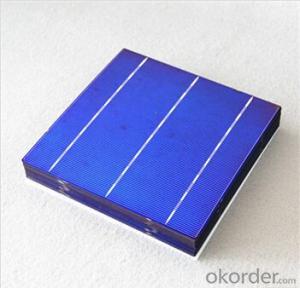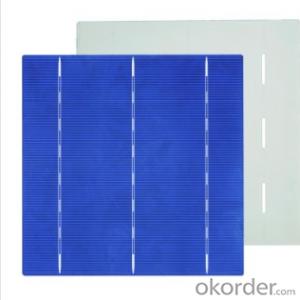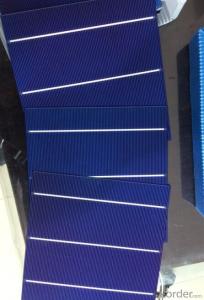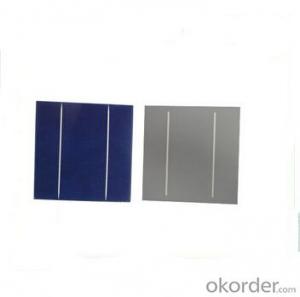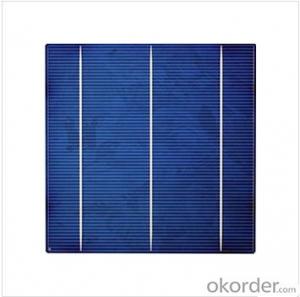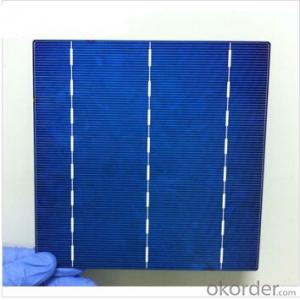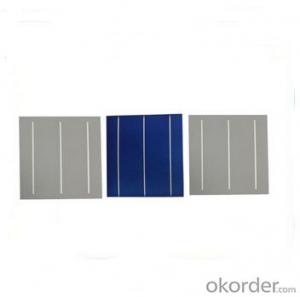Solar Cells Free Polycrystalline Solar Cells Series- 17.00-18.20% 156mmx156mm±0.5mm
- Loading Port:
- Shanghai
- Payment Terms:
- TT OR LC
- Min Order Qty:
- 3000 pc
- Supply Capability:
- 300000 pc/month
OKorder Service Pledge
OKorder Financial Service
You Might Also Like
Solar Cells:
Solar cells is made by solar wafer, it has three categories of solar cell right now, monocrystalline polycrystalline and thin film,These cells are entirely based around the concept PN junction, which is the critical part of solar module, it is the part that can convert the light energy into electricity, the thickness is from 180um to 200um, with even busbars to conduct electricity, textured cell can decrease diffuse reflection; they are often electrically connected and encapsulated as a module. Photovoltaic modules often have a sheet of glass on the front (sun up) side, allowing light to pass while protecting semiconductor wafers from abrasion and impact due to wind-driven debris, rain, hail, etc. Solar cells are also usually connected in series in modules, creating an additive voltage. Connecting cells in parallel will yield a higher current;With high quality and stable quality. Our Cells can greatly improve the performance of Solar Modules.
Features:
1. High conversion efficiencies resulting in superior power output performance.
2. Proven long term mechanical stability of silicon
3. Make of highly purified poly silicon
4. Three bus bars for reduced series resistance and improved module and cell efficiency
5. Blue anti-reflecting coating ensures improved light absorption and increased efficiency
6. Acid texturization offers a uniform appearance and virtually invisible crystal structure
Solar Cells Advantage:
1. Tire-1 Solar Cells’ Manufacturer Quality Guarantee. With a complete and sophisticated quality government system, our Quality Management have arrived world’s leading place. Customer can receive Tire-1 Cells Maker’s Quality Standard Products.
2. Trusted Warranty. We can supply trusted after-sales service to our customer. If our cells are found not in conformity to the specification of manufacturer, or should the inspected quantity found in shortage, or should the packing found damaged, the buyer has the right to claim to the seller. The claim, if any, should be presented to seller within 30 days after cargo's arrival date to the port, together with related inspection report and photos issued and provided by a reputable independent surveyor such as SGS.
3. World’s Leading Manufacturer Equipment. We imported the newest and leading production equipment from abroad. Advanced equipment can guarantee the stable quality of cells. Auto production line can also save labor cost which will further cut our production cost.
Specifications:
Dimension | 156mmx156mm±0.5mm |
Thickness(Si) | 180µm ±20µm, 200µm±20µm |
Front | Blue silicon nitride anti-reflective coatings 1.4mm silver busbar |
Back | Full-surface aluminum back-surface field 2.5mm(silver/aluminum discontinuous soldering pads) |
Efficiency code | 182 | 180 | 178 | 176 | 174 | 172 | 170 | |
Efficiency | Eff(%) | 18.20 | 18.00 | 17.80 | 17.60 | 17.40 | 17.20 | 17.00 |
Power | Ppm(W) | 4.43 | 4.38 | 4.33 | 4.28 | 4.23 | 4.19 | 4.14 |
Max. Power current | Ipm(A) | 8.26 | 8.22 | 8.17 | 8.12 | 8.08 | 8.05 | 7.99 |
Short Circut Current | Isc(A) | 8.71 | 8.68 | 8.63 | 8.60 | 8.56 | 8.53 | 8.49 |
Max. Power Voltage | Vpm(V) | 0.536 | 0.533 | 0.530 | 0.527 | 0.524 | 0.521 | 0.518 |
Open Cirtuit Voltage | Voc(V) | 0.634 | 0.632 | 0.630 | 0.627 | 0.625 | 0.622 | 0.620 |
Efficiency code | 168 | 166 | 164 | 162 | 160 | 158 | 156 | |
Efficency | Eff(%) | 16.80 | 16.60 | 16.40 | 16.20 | 16.00 | 15.80 | 15.60 |
Power | Ppm(W) | 4.09 | 4.04 | 3.99 | 3.94 | 3.89 | 3.85 | 3.79 |
Max. Power Current | Ipm(A) | 7.94 | 7.90 | 7.85 | 7.80 | 7.75 | 7.71 | 7.68 |
Short Circuit Current | Isc(A) | 8.45 | 8.41 | 8.38 | 8.35 | 8.32 | 8.25 | 8.22 |
Max. Power Volgate | Vpm(V) | 0.515 | 0.512 | 0.509 | 0.507 | 0.505 | 0.504 | 0.502 |
Open Circut Voltage | Voc(V) | 0.618 | 0.616 | 0.614 | 0.613 | 0.612 | 0.610 | 0.609 |
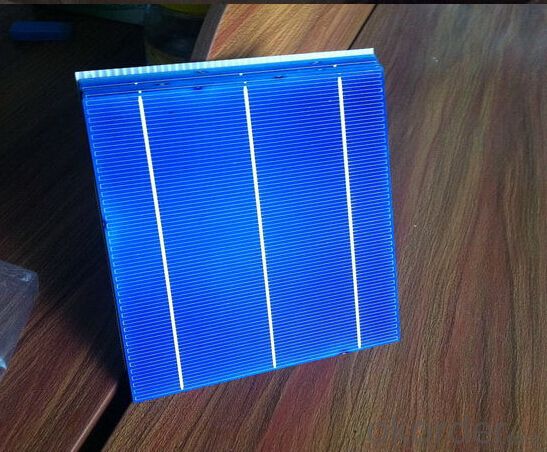
FAQ
We have organized several common questions for our clients,may help you sincerely:
①What price for each watt?
It depends on the efficiency of the solar cell, quantity, delivery date and payment terms.
②How long can we receive the product after purchase?
In the purchase of product within three working days, We will arrange the factory delivery as soon as possible. The pecific time of receiving is related to the state and position of customers.Commonly 7 to 10 working days can be served.
③Can you provide the peripheral products of the solar panels, such as the battery, controller, and inverter? If so, can you tell me how do they match each other?
Yes, we can, we have two companies for solar region, one is CNBM International, the other is CNBM engineering Co.
We can provide you not only the solar module but also the off grid solar system, we can also provide you service with on grid plant.
④What is your warranty of solar cell?
Our product can promise lower than 0.3% open box crack, we support claim after opening the box if it has crackm color difference or sth, the buyer should give pictures immediately, we can not accept the claim after the solar cell has assembled to solar panel.
• Timeliness of delivery
• ⑤How do you pack your products?
We have rich experience on how to pack the solar cell to make sure the safety on shipment, we could use wooden box or pallet as buyer's preference.
- Q: How do solar cells impact greenhouse gas emissions?
- Solar cells have a significant positive impact on greenhouse gas emissions as they generate electricity from the sun's energy without producing any harmful greenhouse gases. By replacing fossil fuel-based energy sources, solar cells help reduce carbon dioxide and other greenhouse gas emissions, mitigating climate change and contributing to a cleaner and sustainable future.
- Q: How do solar cells perform in areas with frequent tornadoes?
- Solar cells can still perform efficiently in areas with frequent tornadoes as they are designed to withstand extreme weather conditions. However, the installation and mounting of solar panels in tornado-prone regions should be done with utmost care and consideration of local building codes to ensure their resilience against high winds. Additionally, regular maintenance and inspection of the solar panels may be required to address any potential damage caused by tornadoes.
- Q: How do solar cells perform in extreme weather conditions?
- Solar cells can perform well in extreme weather conditions, including high temperatures and cold temperatures, as long as they are properly designed and installed. However, extreme weather events such as heavy snow or hailstorms can potentially damage solar panels. Overall, solar cells are quite resilient and can continue to generate electricity even in challenging weather conditions.
- Q: How do solar cells perform in areas with high levels of salt spray?
- Solar cells generally perform well in areas with high levels of salt spray. The materials used in solar cells are designed to be resistant to corrosion and degradation caused by salt exposure. However, regular cleaning and maintenance may be required to ensure optimal performance and prevent any potential buildup of salt deposits on the surface of the solar panels.
- Q: What are the disadvantages of using solar cells?
- One disadvantage of using solar cells is their high initial cost. The installation and purchasing of solar panels can be expensive for homeowners or businesses, making it less accessible for some people. Additionally, solar energy production is dependent on weather conditions, meaning that cloudy or rainy days can lead to reduced efficiency. Finally, the production of solar cells requires rare materials, such as silicon, which can have negative environmental impacts if not managed properly.
- Q: Can solar cells be used in areas with high humidity?
- Yes, solar cells can be used in areas with high humidity. While high humidity can affect the performance of solar cells to some extent, modern solar cell technology is designed to withstand varying environmental conditions, including high humidity. Additionally, regular maintenance and protective coatings can help mitigate any potential humidity-related issues, allowing solar cells to efficiently generate electricity in humid areas.
- Q: What happens to excess electricity generated by solar cells?
- Excess electricity generated by solar cells can be stored in batteries for later use, fed into the power grid to offset energy consumption, or utilized to power other devices or systems within the property.
- Q: Can solar cells be used for powering desalination plants?
- Yes, solar cells can be used for powering desalination plants. Solar energy can be harnessed through photovoltaic panels, which convert sunlight into electricity. This electricity can then be used to power the desalination process, where saltwater is converted into freshwater through various methods such as reverse osmosis or distillation. Utilizing solar cells for powering desalination plants offers a sustainable and renewable energy source, reducing reliance on fossil fuels and minimizing the environmental impact of the desalination process.
- Q: What is the expected degradation rate of a solar cell?
- The expected degradation rate of a solar cell can vary depending on various factors such as the quality of materials used, manufacturing processes, environmental conditions, and maintenance practices. However, on average, a well-designed and properly maintained solar cell can experience an annual degradation rate of around 0.5% to 1%. This means that over time, the solar cell's efficiency may decrease by 0.5% to 1% per year.
- Q: Where can I get the most accurate information about solar cells?
- Don't trust whatever you search online, trust the book.
Send your message to us
Solar Cells Free Polycrystalline Solar Cells Series- 17.00-18.20% 156mmx156mm±0.5mm
- Loading Port:
- Shanghai
- Payment Terms:
- TT OR LC
- Min Order Qty:
- 3000 pc
- Supply Capability:
- 300000 pc/month
OKorder Service Pledge
OKorder Financial Service
Similar products
Hot products
Hot Searches
Related keywords
